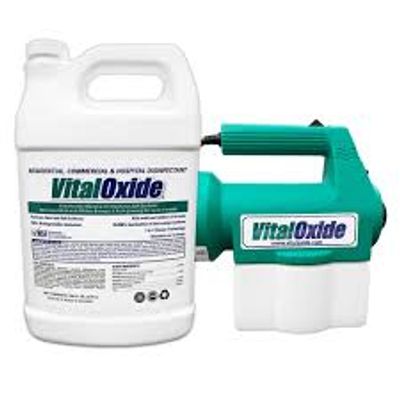24/7 Emergency 772.209.2309

FIGHT THE FLU & COVID-19
Hospital Grade Disinfecting
Vital Oxide has been approved by the EPA for use against SARS-CoV2, the coronavirus that causes the Coronavirus Disease 2019 (COVID 19). We meet the EPA's emerging pathogen requirements for viruses showing efficancy against envelope and non-evelope virus, both large and small.
Hospital Disinfectants FYI
Hospital disinfectants are EPA-registered for use in hospitals, clinics, dental offices, and other medical facilities, and must kill microorganisms often found in healthcare, including S. aureus, S. enterica, and P. aerugionsa. Hospital disinfectants should be used on medical equipment and on environmental surfaces as part of a bundled infection prevention approach. Low, intermediate, and high-level disinfectants can be used in healthcare settings:
Low-Level Disinfectants are EPA-registered hospital disinfectants that are effective for vegetative bacteria, most fungi, and most viruses. Typical active ingredients include quaternary ammonium (quats) or phenols.
Intermediate-Level Disinfectants are EPA-registered hospital disinfectants that are effective against TB, vegetative bacteria, fungi and viruses, and some may have spore claims. Typical active ingredients include 70-90% alcohol, hypochlorite, hydrogen peroxide, phenols, or some quats.
High-Level Disinfectants fall under FDA jurisdiction. They are effective against TB, bacteria, fungi, and viruses, and some, but not all, spores. Typical active ingredients include glutaraldehyde, OPA, hydrogen peroxide, or peracetic acid. These are required for instruments that come in contact with mucus membranes (bronchoscopes, endoscopes), but do not enter sterile body tissues.

Why is Hospital Disinfectant Used?
Hospital-use disinfectants should be used throughout the hospital to disinfect surfaces and medical devices. They are especially important for frequently touched surfaces (e.g., bed rails, bedside table, light switches, phone, TV remote, IV stand, glucometers). Microorganisms are invisible to the naked eye so you can never be sure which surfaces are contaminated and which are not. This is why disinfection is so important. The CDC recommends using “a one-step process and an EPA-registered hospital disinfectant designed for housekeeping purposes in patient care areas where 1) uncertainty exists about the nature of the soil on the surfaces (e.g., blood or body fluid contamination versus routine dust or dirt); or 2) uncertainty exists about the presence of multidrug resistant organisms on such surfaces
How Often Should You Clean?
Occupied patient rooms are generally cleaned and disinfected daily, after adverse events (where gross soil is produced), and upon patient discharge. Every facility should have a cleaning standard agreed upon by environmental services, infection prevention, and management. The CDC indicates:
• Clean housekeeping surfaces (e.g., floors, tabletops) on a regular basis, when spills occur, and when these surfaces are visibly soiled.
• Disinfect (or clean) environmental surfaces on a regular basis (e.g., daily, three times per week) and when surfaces are visibly soiled.
• Use a one-step process and an EPA-registered hospital disinfectant designed for housekeeping purposes in patient care areas where 1) uncertainty exists about the nature of the soil on the surfaces (e.g., blood or body fluid contamination versus routine dust or dirt); or 2) uncertainty exists about the presence of multidrug resistant organisms on such surfaces.
What is the proper dwell time for Cleaners & Disinfectants to be affective?
1. Multiple scientific studies have demonstrated the efficacy of hospital disinfectants against pathogens causing healthcare-associated infections with a contact time of at least 1 minute;
2. The only way an institution can achieve a contact time of 10 minutes is to reapply the surface disinfectant 5-6 times to the surface as the typical dry time for a water-based disinfectant is 1.5-2 minutes and currently,
3. Equally important as disinfectant contact time is the application of the disinfectant to the surface or equipment to ensure that all contaminated surfaces and non-critical patient care equipment are wiped as current studies show,
4. There are no data that demonstrate improved infection prevention by a 10 minute contact time versus a 1 minute contact time
5. We are not aware of an enforcement action against health care facilities for "off label" use of a surface disinfectant.
- Thus, we believe the guideline allows us to continue our use of low-level disinfectants for noncritical environmental surfaces and patient care equipment with a 1 minute contact time. Additionally, all healthcare facilities should reemphasize the thoroughness of cleaning to ensure that all contaminated surfaces are wiped.
GIVE US A CALL FOR A FREE ESTIMATE
Here at Extra Mile Carpet and Tile, We go the "Extra Mile" when we clean your carpet and tile
We Offer Weekend & After Hour Calls & 24/7 Emergency Calls
Extra Mile Carpet & Tile
Hours
Open today | 08:00 am – 06:00 pm |
Copyright © 2023 Extra Mile Carpet & Tile - All Rights Reserved.
Powered by GoDaddy
